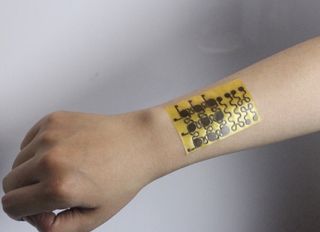This Electronic Skin May Help Prevent Robots from Crushing Us

A metallic robot hand with "Terminator"-like power sounds good for the movies. But what about a real-life future where that android is now cradling your baby or just shaking your hand? That's when attributes like "gentle" and "sensitive" might be more warranted to avoid a human-crushing outcome.
Electronic skin may be the answer, as it could give such robots (and even prosthetic limbs) the ability to sense how forceful their handshakes and cradles are when interacting with humans.
A new electronic skin may also prove more robust than previous versions to prevent accidental damage. It could even heal with the aid of an alcohol-based solution. [Body Bioelectronics: 5 Technologies that Could Flex with You]
Electronic skin, known as e-skin, is made of thin, flexible materials that are studded with pressure, temperature and other kinds of sensors to mimic the function and mechanical properties of human skin. A number of different types of e-skins are under development around the world. For instance, one reported in 2014 was heated to help make prosthetic limbs feel more like living ones. Another e-skin, reported in 2016, possessed electronic hairs to help the e-skin better feel its surroundings.
One weakness of the previous e-skins is that the chemical bonds used to make them were relatively weak. Although they were malleable like human skin, "they were not very robust," meaning they would flimsy, said study co-author Wei Zhang, a biochemist at the University of Colorado at Boulder.
The new e-skin is not only malleable, but also laced with silver particles only nanometers or billionths of a meter thick that boost its mechanical strength and chemical stability, and the resulting chemical bonds lead to stronger e-skin. "It's definitely more robust than people's skin," Zhang told Live Science.

Sensors embedded in the new e-skin measure pressure, temperature, humidity and air flow. "If you want a robot to touch a baby or patient, then how much force will the robot apply?" Zhang said. "That's why these sensors are important — to help the robot sense the right amount of force to apply, and to, say, sense if a baby has a fever."
Sign up for the Live Science daily newsletter now
Get the world’s most fascinating discoveries delivered straight to your inbox.
The researchers noted that if the e-skin gets cut or torn, it will heal with the application of three commercially available compounds dissolved in alcohol. During this rehealing, new molecules grow across the broken surfaces, leading to chemical bonds joining pieces together, mimicking he natural skin rehealing process, the researchers wrote online Feb. 9 in the journal Science Advances.
Moreover, this new e-skin is completely recyclable when dissolved in a solution that can then be used to produce more e-skin.
"Given all the electronic waste that is now generated worldwide each year, it's good that our advance can also help lead to a more sustainable electronic skin," Zhang said.
The scientists now want to collaborate with researchers in the fields of artificial intelligence and biomedical engineering "to integrate these electronic skins with robotics and prosthetics," Zhang said.
Original article on Live Science.

